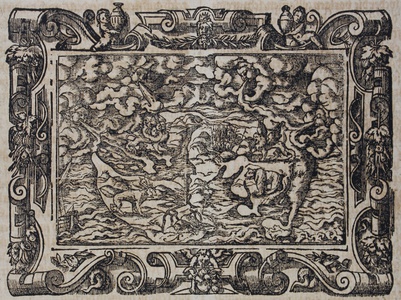| Method | Woodcut |
| Artist | Solis, Virgil and Amman, Jost after Lufft, Hans |
| Published | [Gervinus Calenius et Johan Quentels. Köln, c. 1564] |
| Dimensions | 115 x 155 mm |
| Notes |
The second state of Virgil Solis' world map, a close copy of the famous 'Wittenberg World Map' by Hans Lufft, featuring a visual representation of the Dream of the Four Beasts from the Book of Daniel, this example from a German bible published in Cologne by Calenius and Quentell. Cartographically, the map presents the world in an essentially Ptolemaic fashion with the three continents of Europa, Asia, and Africa. Britain and Scandinavia are absent, and the Western Mediterranean features four unnamed islands, presumably Sicily, Sardinia, Corsica, and either Malta or the Balearics. The sweep of the Aegean is greatly exaggerated, perhaps deliberately exaggerating the position of Constantinople as the lynchpin between East and West. Above the Bosporus, the Black Sea and Caucasus are also absent. In the far east, the putative landmass of India Meridionalis, or the 'Dragon's Tail' can be seen, while the Indian subcontinent has a curious bulge at its tip, perhaps representing a conjoined Sri Lanka. In Africa, the Nile and its theoretical sources are clearly depicted, emanating from the mountains of the Moon. The rest of the continent is heavily truncated, excluding everything south of coastline running horizontally from the Horn of Africa to the bulge of West Africa. Much of the North of the map is obscured by roiling clouds, from which wind-heads blow. A ship can be seen in the southern Atlantic, buffeted on the seas. The whole is surrounded by an elaborate strapwork border, featuring garlands of fruits and leaves, and cupids carrying urns. The most arresting features of the map are the visual depictions of Daniel's dream, located geographically. The first beast, the Lion of the Babylonians, appears in Northern Asia, winged and with gaping jaws. Below, the Bear of the Medes and Persians, occupies central Asia. The third beast, a winged leopard with four heads representing the fractious kingdoms of the successors to Alexander the Great, stands in Europe, facing the vital crossing between East and West. The final beast, Rome, is a hideous goat-like creature, its head crowned with horns. It paces menacingly across Africa, having already subdued the nations of Europe and Asia. In the centre of the map, threatening Europe just as the third beast had threatened Asia is an army on horseback, their lances held aloft. These represent the forces of the Ottoman Turks, whose conquests during the fifteenth and sixteenth century were seen by many in Europe as the first signs of the coming of the biblical apocalypse. The Lufft map, upon which this map was based, was originally cut to illustrate Martin Luther's 1529 pamphlet Vom Kriege wider die Türken. Luther had first discussed the religious implications of the Turks in his Explanation of the Ninety-Five Theses in 1518, where he saw the Ottomans as agents of God's punishment visited upon the excesses of the Catholic Church, and as such, a welcome necessity for the cleansing of sinful Christians. By 1529, with the Ottoman forces knocking on the gates of Vienna, Luther's opinions had changed, and his new pamphlet encouraged Christians to rise to defend themselves against the Turk. In this latter sense, the Turks were seen as the human-headed horn on the crown of the final beast, which in Daniel's Dream erupted from the beast's head, displacing three horns as it did so. The three were seen as the Christian kingdoms of the East, now fallen to the dominion of the Ottomans. The concept proved popular, and the so-called 'Dream Map' was reprinted in Lutheran bibles and theosophical tracts numerous times during the sixteenth century. Lufft's map was superseded in the 1560s by a smaller but much more ornate example designed by Jost Amman and cut by Virgil Solis. Virgil Solis (1514-1562) was a German printmaker and publisher, and the scion of a large family of Nuremberg artists. Solis produced illustrations on all manner of subjects, though he is best known for his biblical and classical scenes, particularly the large number of woodcuts which appeared in numerous sixteenth century editions of Ovid's Metamorphoses. Jost Amman (1539-1591) was a Swiss-German printmaker and publisher, born in Zurich, but working for the majority of his life in Nuremberg, where he was apprenticed to the woodcut artist Virgil Solis. One of the most prolific woodcut artists of the sixteenth century, Amman is believed to have drawn and cut over 1500 prints. He is particularly celebrated for his numerous biblical prints, and a series of Bavarian topographical views commissioned by the cartographer and mathematician Philipp Apian. Hans Lufft (1495-1584) was a German printer and bookseller. Based in Wittenberg, he became one of the most prominent figures of the Reformation, due to his publishing of the first complete edition of Luther's Bible, as well as Luther's subsequent theological works. Shirley 65A (After) Condition: Time toning to sheet. Offsetting from woodblock text on back of sheet. Gothic title above and two columns of German text below. Monogrammed 'A' and 'VS' at bottom of woodblock. |
| Framing | unmounted |
| Price | £900.00 |
| Stock ID | 43929 |

